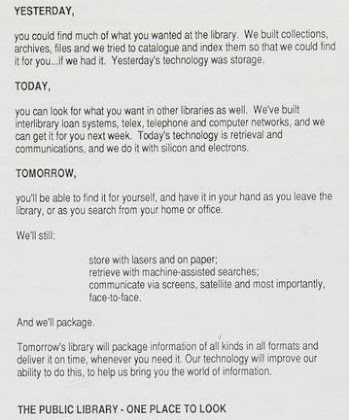 |
| Egerton Ryerson, n.d. |
I mean the establishment of Circulating Libraries in the various Districts, and as far as possible in the School Sections. To the attainment of this object, local and voluntary co-operation is indispensable. Government may perhaps contribute; it may assist by suggesting regulations, and recommending list of books from which suitable selections can be made; but the rest remains for individual and local efforts to accomplish. And the advantages of the School can be but very partially enjoyed, unless they are continued and extended by means of books.
Over the course of his superintendency, hundreds of school libraries were formed and hundreds of thousands of books were delivered to local communities through the agency of a Book Depository which was established in Toronto. It offered discount prices on books. But, eventually, with the expansion of the frontier in Ontario and population growth, urban communities found public school libraries less attractive to an alternative appearing in Britain and the United States—free municipal public libraries. As well, the government was helping fund another source of library books in hundreds of mechanics’ institutes and frequently petitioned by a small, developing book trade to abolish the Depository’s monopoly. Nevertheless, Ryerson stood his ground, and the school libraries he created and nourished remained in place until the Depository closed in 1881 and the Ontario Legislature passed the Free Public Libraries Act in 1882. His system is often described as a failure. At the time of his retirement it was said that small classroom libraries were ‘read-out,’ that most adults had turned to collections in mechanics’ institutes, and that the libraries had languished under inattentive local management by school authorities. However, Ryerson did establish an important library legacy: universal access to libraries, service for both children and adults, and the use of tax money for libraries which gained wider acceptance eventually leading to free library legislation.
The original presentation lasted about a half hour with questions afterwards and follows below. There is no commentary in the MP4 video of the PowerPoint presentation I made in 2007. It is about a 20-minute read, and viewers should adjust the settings to the slowest slide speed, i.e., 25 seconds.
Regarding the conclusion, there was some discussion at OLA, so perhaps a bit more information would be helpful for viewers. The concept of models is often used in historical explanations. The concept of ‘state formation’ has become important in the colonial experience of Canada West, 1841–67. State formation is the process whereby governing bodies during the period of growing responsible government and public institutions (such as libraries) exercised greater regulatory powers. In this development, government gained greater authority over the urban and rural populace ensuring the advance of liberal democratic rule and inculcating moral, cultural, and economic values aligned with capitalism. Bruce Curtis wrote on this topic four decades ago: “‘Littery Merrit,’ ‘Useful Knowledge,’ and the Organization of Township Libraries in Canada West, 1840–1860,” Ontario History 78, no. 4 (1986): 285–311. He concluded that while libraries were believed to promote certain ideals, such as literacy, his research indicated that few adults read the books supplied through Ryerson’s system because book selection was centrally controlled and officially excluded much published literature through the agency of the Book Depository. If the Dept. of Public Instruction and Ryerson himself sought to purposely make the people of Canada West (later Ontario) more governable, there must be some doubt about the success of the Ryerson system.
It seems, too, difficult to make the case for another useful model, social control. Social control was a popular topic in library history and education, especially in America, beginning with the revisionist histories of the 1970s. There are many articles concerning its pros and cons due to its imprecise nature. Did Ryerson set out to use libraries to structure controls around public reading as well as provide moral instruction? It is a good question, yet the success of his scheme often relied on local responses, so it is fair to say that there was not just compliance but collaboration in building libraries. Also, there were many limitations to the concept of social control in library history: the degree of general public acceptance, the different levels of public usage, and opponents, especially booksellers or reluctant politicians and taxpayers.
A third model, the one I followed in my Free Books for All: The Public Library Movement in Ontario, 1850-1930, is less structured, libraries as a social movement. In short, people and groups from all sectors of the population organize formally or informally to support and produce societal or political change. Ryerson’s system displays a political characteristic of liberal democracy: a partnership between central and local authorities with the aim to establish public institutions. The central body instructs and local bodies supply the services. The political values are efficiency and participation in representative, responsible government. In time, a successful movement will eventually diminish because its objectives are mostly achieved and into woven into the fabric of government. Thus, the government sponsorship of libraries and universal public access that Ryerson espoused fits this general context until about 1930 when all the major cities and towns in Ontario had established free library service through local plebiscites.
Another influential Canadian historical thesis, the ‘liberal order framework’ proposed by Ian McKay, asserts that liberal-minded politicians and business leaders successfully shaped the nation’s consensus around individualism, private property and capitalist accumulation. This thesis is influenced by the Marxist philosopher, Antonio Gramsci, who developed the concept of cultural and social hegemony that reinforced the power of dominant classes. In this political environment, the impetus to create libraries would come from powerful individuals or groups seeking to legislate-regulate libraries and public reading by a ‘top down’ process. Gramsci is an important representative of Western Marxism.
The ongoing application of new models and theoretical approaches to library history may inject alternative views of the library system Ryerson developed over a quarter-century. Certainly, the recent development of ‘critical ibrarianship,’ which strives to examine librarianship and library structures in relation to systemic ideologies, offers an opportunity to re-investigate power/knowledge relationships identified by Michel Foucault. For example, his formulation of governmentality (governing people’s conduct through positive means) offers a theory of examining power relations in a different way. The prospect of other approaches looms in the future, but these were not part of my 2007 presentation.
Further information on my history of free public school libraries in Canada West can be viewed on the Internet Archive in my Free Books for All: The Public Library Movement in Ontario, 1850-1930 published in 1994.

